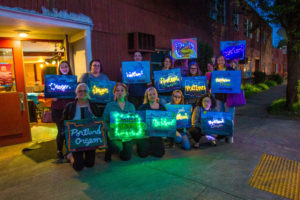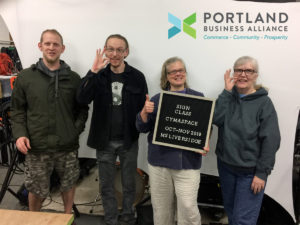Welcome
Why learn ASL?
Estimates from the SIPP* indicate that approximately 1 in 20 Americans are deaf or hard of hearing. In round numbers, nearly 10,000,000 persons are hard of hearing and close to 1,000,000 are functionally deaf. With approximately 1,000,000 people across all ages who are functionally deaf, or 3.8 functionally deaf people per 1,000 people over 5 years of age, this is a large and underserved segment of the population. The exact number of people with other disabilities who use ASL is unknown at this time. The mission of Sign Class is to help make businesses and families not only more Deaf-friendly but inclusive for all. By doing so, Deaf people and others with disabilities will feel empowered and have access and not feel isolated or swept aside.
According to research, the unemployment rate for the deaf and hard of hearing population is still more than 60 percent. Public places still do not always accommodate or provide access for deaf and hard of hearing people. A lot of discrimination is tied to ignorance of the deaf culture and the beautiful language that flows through it. Hearing people tend to think of deafness as a simple disability: an inability to hear. I want to help change all this with Sign Class.
*The SIPP is the Survey of Income and Participation is a multi-wave panel survey conducted annually by the U.S. Census Bureau.
Other reasons to learn ASL?
ASL is one of the most popular languages to learn and one of the most widely used in the U.S. in addition to English, Spanish and Chinese. It is a rich language with its own grammatical order and syntax. ASL has gained incredible exposure from entertainers who are Deaf including Marlee Matlin, who won an Oscar for her portrayal of Sarah in Children of a Lesser God and Nyle di Marco, who won the top prize at America’s Next Top Model and Dancing With the Stars. With ASL, you can sign with friends, loved ones, co-workers and pets who are Deaf or hard of hearing, under water, across the room, etc.!
My Communication Style
My approach to communication during my lifetime has been a bilingual-bicultural one: I am proficient in English and speak intelligibly. I am able to carry on a conversation one-on-one with another English speaker, but in a group I prefer to have an ASL interpreter there so I don’t miss anything.
My 6-12 week program
I offer live ASL classes tailored for businesses, families and individuals. People can sign up using a Zoom link. The ASL curriculum will focus first on ameliorating mistakes I’ve seen from having taught a multitude of ASL students- namely related to facial expressions. Since non-manual signals or markers are an important part of ASL grammar, this topic will be mastered in the beginning. Non-manual markers include, for example, how signers move their eyebrows when signing question sentences. The rest of the curriculum will have a multitude of ASL and Deaf Culture topics, including myths about deafness and the Deaf community, proper use of pronouns, introductory dialogues in ASL, emotions, noun-verb pairs, negatives, classifiers, describing people, directional signs, English-ASL translation and many more. The goal of completing this non-credit course is to have each student be able to carry a basic conversation in ASL and have basic knowledge of Deaf culture and how to interact with the D/HH community.
![]()



